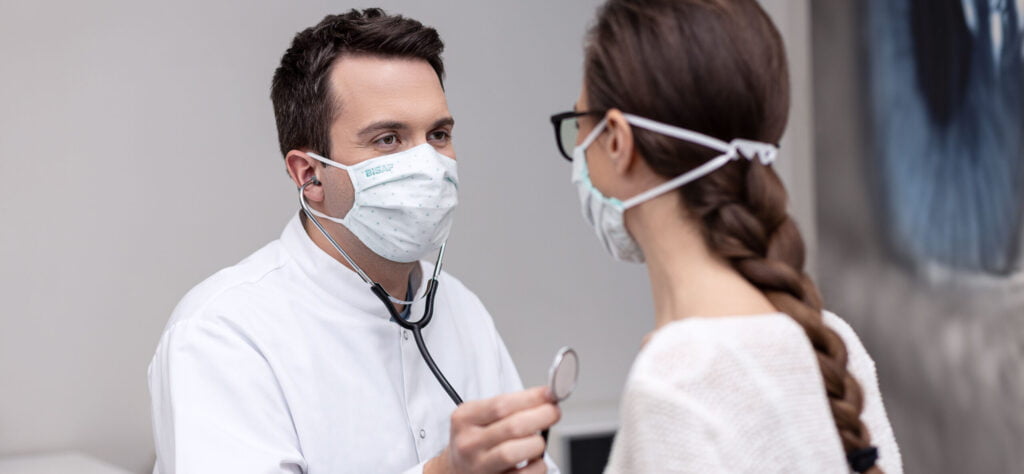Medical masks
Medical masks, also called surgical masks, are not among the respiratory protection measures that protect against biological agents. First of all, they provide protection against droplet contamination on the part of the user of the medical mask. This means that the person wearing this type of mask mainly protects others, not themselves. However, medical masks are sufficient during normal patient care, and models with higher bacterial filtration efficiency are commonly used during surgery.

Protection classes
EN 14683 standard segregates medical masks based on Bacterial Filtration Efficiency (BFE), differential pressure (breathing resistance), and resistance to seepage. Based on this standard, the following protection classes are distinguished:
- Type I – BFE bacterial filtration efficiency ≥ 95%
- Type I R – BFE bacterial filtration efficiency ≥ 95% and resistance to penetration
- Type II – BFE bacterial filtration efficiency ≥ 98%
- Type II R – BFE bacterial filtration efficiency ≥ 98% and resistance to penetration
The use of medical masks
The task of medical masks is primarily to protect patients from getting infected as a result of contact with medical personnel. They are assumed mainly during surgery or other treatments. Medical masks are also intended to protect doctors and other people working in medical facilities from getting into their body blood and body fluids of patients. The threat to medical staff may be, for m.in example, blood aerosols, infectious particles entering the air during laser use, participation in the disinfection process or contact with patients suffering from tuberculosis, diphtheria, pneumonia, and many other infectious diseases. However, if the level of danger is high and the user is to work in a dusty atmosphere, it is recommended to use FFP filtering half-masks instead of medical masks.
Medical masks are used:
– to provide patients with sterile conditions, for example during surgery;
– to a limited extent to ensure the protection of medical personnel who are exposed to patients’ blood and body fluids;
– to protect against the entry of bacteria or viruses into the environment (but are not sufficient for the user himself, who has the possibility of getting infected);
– to protect against large particles that are transmitted by droplets.
Medical masks are only suitable for single use due to the fact that they become damp at a fairly fast pace, which in turn leads to an increased risk of leakage. Its service life also depends on the level of humidity and ambient temperature. For this reason, you should remember to regularly replace the mask with a new one. Surgical masks do not filter the air but create a physical barrier between the mucous membranes and pollution. They protect against particles with a diameter of not less than 100 μm, which means that, as a rule, they are not effective enough for viruses. However, they are an effective barrier in the case of droplet secretions, which may also contain viruses. Surgical masks fit loosely to the face and are not tight, which also does not provide the user with sufficient protection.
EN 14683 standard does not apply to masks that are intended solely for the protection of medical personnel. If the aim is to protect the user from contracting viruses, bacteria, or fungi, as well as to prevent the spread of a pandemic, devices that meet the EN 149 standard’s standard should be used. It is worth paying attention to the following list:
– According to EN 14683 standard, the filtration efficiency is tested with a particle with an average size of 3 μm.
– According to EN 149 standard, the filtration efficiency is tested with a particle of medium size of 0.4 and 0.6 μm.
Therefore, a medical mask is not effective enough for viruses. In such a situation, filtering half-masks are definitely a better choice.

